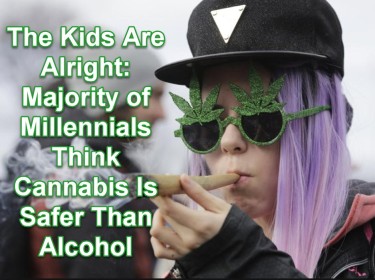
Why the ‘Yutes’ prefer weed to other drugs
Study: Young Adults’ Consumption of Alcohol, Cigarettes, Other Substances Fell Following Marijuana Legalization from EverythingScience
It turns out that today’s youth are much more interested in using cannabis than smoking tobacco and drinking alcohol. While some may think this is bad news, it’s actually much better news than you might expect.
Before diving into the content of the article, let’s take a closer look at what the latest study has revealed and how it will impact drug trends in the years to come.
According to a reporter at NORML, an organization that has long advocated for the national legalization of cannabis, the article read:
Researchers from the University of Washington assessed trends in alcohol, nicotine, and over-the-counter pain medication use among a cohort of over 12,500 young adults (aged 18 to 25) in Washington state following the legalization of adult-use cannabis.
They reported, “Contrary to concerns about spillover effects, the introduction of legalized, non-medical cannabis coincided with a decline in alcohol and cigarette use and painkiller abuse.” The researchers found that the prevalence of E- Cigarette use has increased in the past month following legalization.
The authors concluded: “Our results demonstrate that the legalization of non-medical cannabis has not led to a dramatic increase in the use of alcohol, cigarettes and non-prescription opioids. … The results indicate that the most critical public health concerns related to cannabis legalization and the development of legalized cannabis markets may be specific to cannabis use and its associated consequences.”
Commenting on the study’s findings, NORML Associate Director Paul Armentano said: “Real data from legalizing states refutes long-standing claims that cannabis is some kind of ‘gateway substance’. In fact, in many cases, cannabis regulation is associated with reduced use of other substances, including many prescription drugs.” – NORMAL
Essentially, researchers in Washington have confirmed something cannabis activists have known since the dawn of modern legalization. If you legalize and regulate cannabis, there are no associated increases in other drugs – and apparently it has the opposite effect.
It seems that cannabis acts more as a “gateway out of drugs,” as we discussed in an article last week. What we see is that people tend to swap their other drugs for cannabis. Medical patients use fewer opioids, tobacco addicts quit, alcoholics significantly reduce their use, psychiatric patients reduce their anxiolytic use, and more.
What we’re seeing is that cannabis, in a way, consolidates the effects of all these other substances and offers a more robust return on investment.
I personally prefer to get stoned…
I’ve long since stopped drinking, except when I want to hum a little. However, for me, alcohol is almost like taking a harder drug. I don’t just take LSD, I always take it on purpose. Likewise, I don’t open a bottle of wine or whiskey unless I want to get a little tipsy.
However, I can go months or even years without wanting or needing alcohol. For me, cannabis is my main drug and has been for over twenty years. That’s because I don’t get the hangovers I get from alcohol and I don’t have the severe withdrawals I get from tobacco.
Also, because cannabis takes longer to consume per gram than tobacco, it lasts longer, meaning I have to spend less money to get almost the same effects that alcohol and tobacco would give me.
It seems that even the young have recognized this truth.
Young people prefer vaping
While I’m an old-school stoner who still loves joints, blunts, pipes, and bongs, kids these days prefer vaping. Don’t get me wrong, I’m not against the idea of vaping either. I have my own Pax unit and I love it!
However, young adults primarily consume in the vaporized format, mainly for its convenience, ease of use and overall discretion compared to the other formats.
A recent study published in the Journal of Addiction confirms this trend;
According to a study by the Columbia University Mailman School of Public Health, vaping cannabis is becoming the most popular method of cannabis administration among all adolescents in the United States, as is the frequency of cannabis vaping. The study found that the frequency of cannabis vaping among adolescents across all demographic groups is reported six or more times per month and is increasing faster than occasional use. Those who vape and smoke nicotine are more than 40 times more likely to also vape and smoke cannabis.
Until now, time trends in vaping use have been largely unexamined, including trends in frequency of use, emerging inequalities, and concomitant use of other substances, all of which are critical to public health surveillance and programmatic efforts. The results are published in the journal Addiction.- Source
Of course, the study focuses more on an alarmist perspective, but the fact remains that kids today vape more than any other way.
Is that good or bad?
Of course we want our youth to be as “drug free” as possible. However, if they choose cannabis over alcohol and tobacco, they will experience fewer adverse effects on a physiological level. Unlike alcohol, cannabis is not associated with violent behavior and unlike tobacco, it is far less addictive.
That’s not to say children aren’t at risk of addiction, but if we have to choose between the lesser evils, cannabis use is far less harmful than the other mainstream drugs.
Now it’s about drug education. But one thing is for sure, today’s youth aren’t as keen on being “wiped out” as my generation was, but they also smoke stronger forms of cannabis – so ultimately who knows what will happen.
For now, it looks like cannabis will gain market share in the years to come, and next generations will use it much more openly than previous generations. The world is finally going green. As it should always be.
YOUTH AND CANNABIS USE, READ MORE…

THE KIDS PREFER CANNABIS TO BOOZE, HERE’S WHY!

Post a comment: